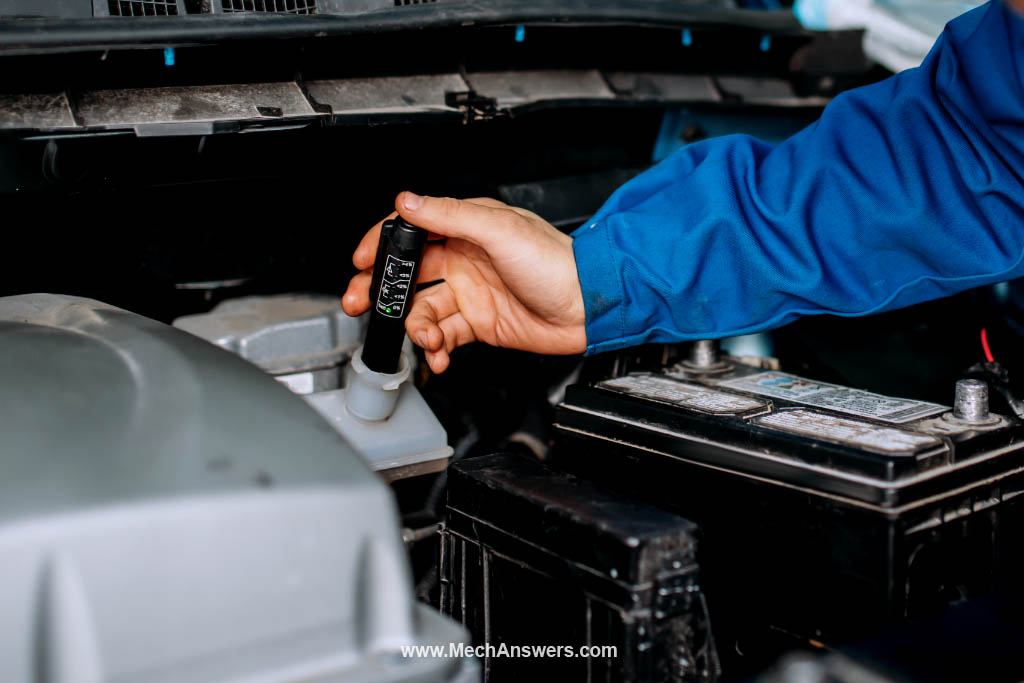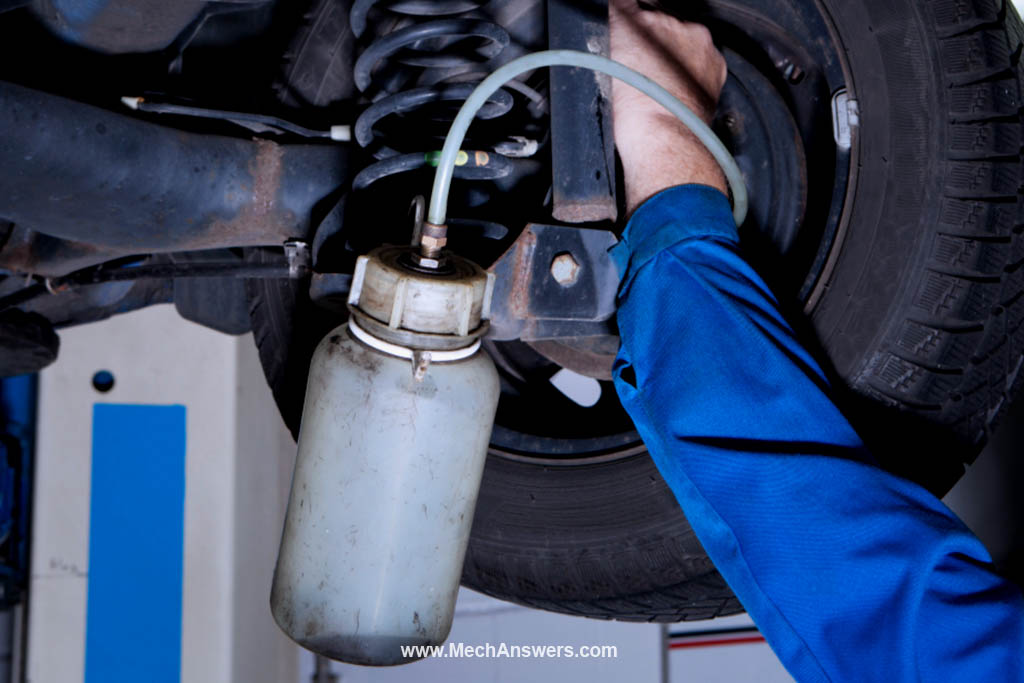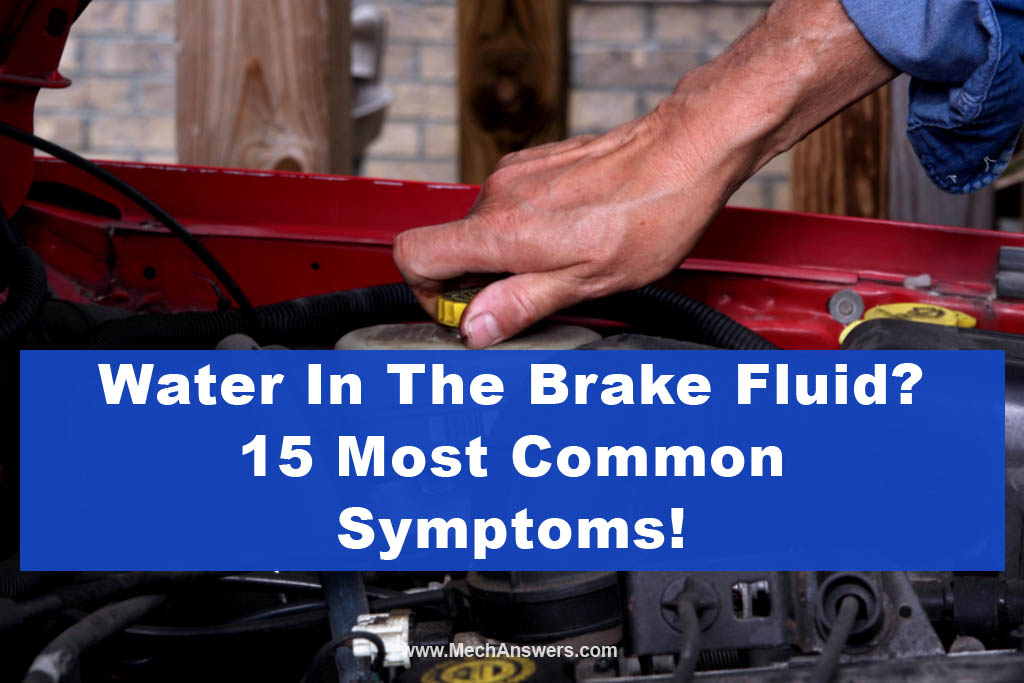As a driver, you’ve likely had many questions about your vehicle’s maintenance and safety, and perhaps you’ve found yourself searching for “Water In Brake Fluid?” Well, search no more, as this article will provide you with the answers you need.
So, what can you expect if there is “Water In Brake Fluid?” The presence of water in your brake fluid can lead to severe performance issues, including decreased braking efficiency, internal corrosion of brake system components, and in severe cases, brake failure.
Reading this article will equip you with the ability to recognize the symptoms of water-contaminated brake fluid and provide you with solutions on how to fix this critical issue. Understanding these aspects is crucial to ensure your vehicle’s safety and longevity.
Table of Contents
Why Is Water Contamination A Problem In Brake Fluid?
Water contamination in brake fluid is a common problem that can have serious consequences for your vehicle’s braking performance and safety.
But why is water in brake fluid such a big issue? In this section, we’ll explore how water contamination occurs, why it’s problematic for brake fluid, and the consequences of using water-contaminated brake fluid.
Firstly, how does water contamination occur in brake fluid? Over time, brake fluid can absorb moisture from the air through microscopic pores in rubber hoses and seals, leading to water contamination.
This is particularly true in humid or wet climates, where moisture levels are higher. Water can also enter the brake fluid if there is a leak in the brake system or if the fluid is not properly maintained.
So why is water in brake fluid such a problem? A brake fluid is a hydraulic fluid that transmits the force from the brake pedal to the brakes themselves. It’s designed to have a high boiling point to withstand the heat generated during braking.
When water enters the brake fluid, it reduces the boiling point and can cause the fluid to vaporize under heavy braking. This can lead to reduced braking performance, or even brake failure, in extreme cases.
In addition to reduced braking performance, using water-contaminated brake fluid can have other consequences. Water can cause corrosion in the brake system, leading to damage and potential failure of brake components.
It can also lead to increased wear on brake pads and rotors and can affect the function of anti-lock brake systems (ABS).
The 15 Most Common Symptoms of Water in Brake Fluid
Water contamination in brake fluid is a common problem that can have serious consequences for your vehicle’s braking performance and safety. In this section, we’ll explore the 15 most common symptoms of water contamination in brake fluid, how to recognize these symptoms, and how they can affect braking performance.
Reduced braking performance:
One of the most common symptoms of water contamination in brake fluid is reduced braking performance. If your brakes feel spongy or don’t respond as quickly as they should, it could be a sign of water contamination.
Soft or mushy brake pedal:
A soft or mushy brake pedal can also be a sign of water contamination in brake fluid. This can make it difficult to apply the brakes effectively and can reduce stopping power.
The brake pedal travels too far:
If the brake pedal travels too far before the brakes engage, it could be a sign of water contamination in the brake fluid. This can be particularly dangerous in emergencies where you need to stop quickly.
Longer stopping distances:
Water contamination in the brake fluid can lead to longer stopping distances, as the brakes are less effective at slowing the vehicle down.
Brakes grab or pull to one side:
If your brakes grab or pull to one side, it could be a sign of water contamination in the brake fluid. This can cause uneven wear on brake components and affect the vehicle’s handling.
Brake fluid appears dirty or discolored:
If the brake fluid appears dirty or discolored, it could be a sign of water contamination. Brake fluid should be clear or light brown.
Corrosion on brake components:
Water contamination in the brake fluid can cause corrosion on brake components, such as calipers and rotors. This can affect the function of these components and lead to brake failure.
Unusual sounds:
Water contamination in the brake fluid can cause unusual sounds when you apply the brakes, such as squeaking or grinding. This can indicate that the brake pads or rotors are worn or damaged.
Burning smell:
If you smell burning when you apply the brakes, it could be a sign of water contamination in the brake fluid. This can occur when the fluid boils and produces vapors.
ABS warning light:
Water contamination in the brake fluid can affect the function of anti-lock brake systems (ABS) and trigger the ABS warning light on your dashboard.
Brake warning light:
If the brake warning light on your dashboard comes on, it could be a sign of water contamination in the brake fluid. This could indicate a problem with the brake system that requires attention.
Brake fluid level drops:
If the brake fluid level drops consistently, it could be a sign of a leak in the brake system or water contamination in the brake fluid.
Increased pedal effort:
Water contamination in the brake fluid can require increased pedal effort to apply the brakes, making it harder to stop the vehicle effectively.
Reduced brake pad life:
Water contamination in the brake fluid can lead to increased wear on brake pads, reducing their lifespan and requiring more frequent replacement.
Brake failure:
In extreme cases, water contamination in the brake fluid can lead to complete brake failure, making it impossible to stop the vehicle safely.
By recognizing these 15 symptoms of water contamination in brake fluid, you can take action to prevent and fix the issue.
In the next section, we’ll explore how to diagnose water contamination in brake fluid and what steps you can take to address the problem.
How to Test for Water in The Brake Fluid
Testing for water contamination in brake fluid is an important part of vehicle maintenance, and can help ensure that your brakes are functioning properly.
In this section, we’ll explore how to test for water contamination in brake fluid, the types of brake fluid testers available, and why regular testing is important.
To test for water contamination in brake fluid, you’ll need a brake fluid tester. There are two main types of testers: test strips and electronic testers.
Test strips are paper strips that change color based on the level of water contamination in the brake fluid.
Electronic testers use a probe to measure the boiling point of the brake fluid and indicate whether there is water contamination present.
Here is a step-by-step guide on how to test your brake fluid for water contamination:
1. Gather the necessary materials:
You will need a brake fluid tester, which can be either test strips or an electronic tester. Make sure to read the instructions for the tester before using it.
2. Locate the brake fluid reservoir:
The brake fluid reservoir is typically located on the driver’s side of the engine compartment. Consult your vehicle’s owner’s manual if you’re unsure where to find it.
3. Remove the cap from the brake fluid reservoir:
Use a screwdriver or pliers to remove the cap from the brake fluid reservoir.
4. Clean the area around the reservoir cap:
Use a clean rag or paper towel to wipe away any debris or dirt around the reservoir cap. This will help prevent contamination of the brake fluid.
5. Dip the test strip or probe into the brake fluid:
If using test strips, dip the strip into the brake fluid and wait for it to change color. If using an electronic tester, heat the brake fluid and insert the probe into the fluid to measure the boiling point.
6. Compare the color of the test strip to the chart provided:
If using test strips, compare the color of the strip to the chart provided with the strips to determine the level of water contamination.
7. Interpret the results:
If the test indicates water contamination is present, it’s time to change the brake fluid. If the contamination is severe, it may be necessary to flush the entire brake system and replace the brake fluid.
8. Replace the reservoir cap:
Once you have finished testing the brake fluid, replace the cap on the reservoir and ensure it is securely tightened.
9. Record the results:
Keep a record of the brake fluid test results and the date of the test. This will help you track the condition of your brake fluid over time and identify any changes in its performance.
Regular testing for water contamination in brake fluid is important for several reasons. First, it can help prevent costly repairs by catching problems early. Water contamination in the brake fluid can lead to corrosion and damage to brake components, so catching it early can help prevent the need for expensive repairs.
Second, regular testing can help ensure that your brakes are functioning properly and that you’re driving safely. Water contamination can compromise the performance of your brakes, reducing their effectiveness and potentially putting you at risk while driving.

How to Fix Water in Brake Fluid
Water contamination in the brake fluid can compromise your vehicle’s braking performance and put you at risk while driving. Here is a guide on how to fix water contamination in brake fluid:
1. Drain and replace the brake fluid:
The most effective way to remove water from the brake fluid is to completely drain and replace it. This can be done by a professional mechanic or a skilled DIYer.
2. Bleed the brake system:
After replacing the brake fluid, it’s important to bleed the brake system to ensure that all of the air bubbles are removed. This can be done using a brake bleeder kit or by manually bleeding the brakes.
3. Inspect the brake components:
Water contamination can cause corrosion in the brake system, so it’s important to inspect the brake components for any signs of damage or wear. Replace any damaged parts as needed.
4. Check for leaks:
Water contamination can also cause leaks in the brake system, so it’s important to check for any signs of fluid leakage. This can be done by visually inspecting the brake lines and calipers, or by using a pressure testing kit.
5. Test the brakes:
After fixing water contamination in the brake fluid, test the brakes to ensure they’re working properly. Take your vehicle for a test drive and perform a few hard stops to test the braking performance.
To prevent water contamination in the future, here are some tips:
1. Use high-quality brake fluid:
Always use a high-quality brake fluid that meets the specifications recommended by your vehicle’s manufacturer.
2. Keep the brake fluid reservoir clean:
Dirt and debris can contaminate the brake fluid, so keep the reservoir clean and free of debris.
3. Check the brake fluid regularly:
Regularly check the brake fluid level and condition, and test for water contamination periodically.
4. Replace the brake fluid on schedule:
Brake fluid should be replaced on a regular schedule, usually every 2-3 years, regardless of mileage.
Common Causes of Water in Brake Fluid
Water contamination in the brake fluid can lead to reduced braking performance and potential safety hazards while driving. Understanding the common causes of water contamination can help you take steps to prevent it from occurring. Here are some of the most common causes of water contamination in brake fluid:
1. Condensation:
Water can enter the brake system through condensation when there are temperature changes. Moisture can form when the brake fluid cools down, and then the water can settle in the bottom of the brake lines or the brake fluid reservoir.
2. Water infiltration:
Water can also enter the brake system when there is external infiltration of water. This can happen if a vehicle is driven through deep water or if water is sprayed onto the brake system during cleaning or washing.
3. Contaminated brake fluid:
Brake fluid can become contaminated with water if it is not stored properly or if the container is left open. Contaminated brake fluid can also be caused by using water to dilute brake fluid, which is not recommended.
The Effects of Water on Brake Components
Water contamination in the brake fluid can have severe effects on the brake components of a vehicle. Here are some of the ways that water contamination can affect brake components:
1. Corrosion:
Water contamination in the brake fluid can lead to corrosion of the brake system components, including the calipers, pads, and rotors. Corrosion can cause the parts to deteriorate and weaken, ultimately reducing their ability to function correctly.
2. Reduced braking performance:
Water contamination can also reduce the performance of the brake system. Water in the brake fluid can lead to reduced friction between the brake pads and rotors, reducing the ability of the brake system to slow or stop the vehicle effectively.
3. Brake fade:
Brake fade is another possible effect of water contamination in brake fluid. Water can boil under high temperatures and cause air bubbles in the brake lines, leading to brake fade. Brake fade can be dangerous because it can reduce the ability of the brake system to slow or stop the vehicle.
5. Increased wear and tear:
Water contamination in the brake fluid can lead to increased wear and tear on the brake components. This can cause the brake system to fail more quickly, which can be a safety hazard for drivers and passengers.
How To Drain Brake Fluid?
Draining brake fluid is an essential part of maintaining the brake system of a vehicle. It is necessary to remove old or contaminated fluid to ensure that the brake system functions correctly. Here is a step-by-step guide on how to drain brake fluid:
1. Gather the necessary materials:
You will need a brake fluid drain tool, a drain pan, a wrench or pliers, and a new bottle of brake fluid.
2. Locate the brake fluid reservoir:
The brake fluid reservoir is typically located near the firewall on the driver’s side of the vehicle. It is a small plastic container with a cap that says “brake fluid.”
3. Remove the cap from the brake fluid reservoir:
Use a wrench or pliers to remove the cap from the brake fluid reservoir. Be careful not to spill any brake fluid on the engine or surrounding components.
4. Attach the drain tool to the brake fluid reservoir:
Insert the brake fluid drain tool into the reservoir and turn it clockwise until it is tight.
5. Place the drain pan underneath the vehicle:
Position the drain pan underneath the vehicle where the brake fluid will drain.
6. Open the drain valve:
Open the valve on the brake fluid drain tool to allow the fluid to drain into the pan.
7. Wait for the fluid to drain:
Wait for the fluid to drain completely from the brake system. It is recommended to let the fluid drain for at least 15 minutes to ensure that all the old fluid is removed.
8. Close the drain valve:
Once the fluid has finished draining, close the valve on the brake fluid drain tool.
9. Refill the brake fluid reservoir:
Fill the brake fluid reservoir with new, clean brake fluid. Be sure to use the type of brake fluid recommended by the manufacturer.
10. Bleed the brake system:
After filling the reservoir, bleed the brake system to remove any air bubbles that may have entered the system during the draining process. This can be done by pumping the brakes or using a brake bleeding kit.

Related Articles
Read more >> Temporary Fix For Stuck Brake Caliper. Step-by-Step Guide!
Read more >> How Long Does It Take For Brake Fluid To Circulate?
Read more >> Transmission Fluid is Leaking From Front of the Car? (Facts)
Read more >> 10 Best Methods For Temporary Fix Grinding Brakes!
Water In Brake Fluid – Testing Brake Fluid for Water Saturation >> Check out the video below:
Conclusion
Being able to recognize the symptoms of water contamination in brake fluid is crucial for ensuring the safety and functionality of your vehicle’s braking system. By knowing what to look out for, you can take prompt action to address any issues and prevent more severe consequences such as brake failure.
Regularly testing and maintaining your brake fluid can help prevent water contamination and extend the lifespan of your vehicle’s brake components. If you suspect water contamination in your brake fluid, it is essential to take the necessary steps to address the issue promptly.
With this knowledge, you can ensure that your vehicle’s braking system remains in optimal condition and provides reliable stopping power for safe driving.
Reference Source:
www.holtsauto.com/prestone/news/understanding-brake-fluid-101/

